The Dry Stone Conservancy: Building a Rock Fence Renaissance
Stacy B. Williams
Special Contributor
Photos provided courtesy Dry Stone Conservancy
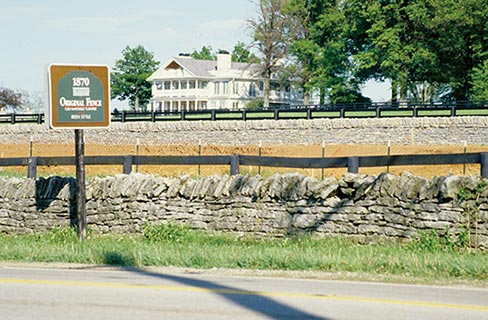 This is a story about the Dry Stone Conservancy, a nonprofit organization based in Lexington, Kentucky that is dedicated to preserving historic drystone structures and promoting the ancient craft of dry-laid stone masonry.
This is a story about the Dry Stone Conservancy, a nonprofit organization based in Lexington, Kentucky that is dedicated to preserving historic drystone structures and promoting the ancient craft of dry-laid stone masonry.
 Although the Conservancy was born in 1995, we’ll begin our story a little earlier to understand the framework and foundation of its inauguration.
Although the Conservancy was born in 1995, we’ll begin our story a little earlier to understand the framework and foundation of its inauguration.
 In the 1960s, the idea of widening Paris Pike, the highway connecting Paris and Lexington, Kentucky, seemed necessary because of its increasing traffic problems and fatality rate. However, it became a serious issue of contention among residents in Bourbon and Fayette counties, and especially landscape historians.
In the 1960s, the idea of widening Paris Pike, the highway connecting Paris and Lexington, Kentucky, seemed necessary because of its increasing traffic problems and fatality rate. However, it became a serious issue of contention among residents in Bourbon and Fayette counties, and especially landscape historians.
The limestone rock fences along Paris Pike, nearly 200 years old and over six miles long, were suddenly in danger of destruction.
 By the 1990s, after decades of discussion and debate, the Kentucky Transportation Cabinet (KyTC) hired a landscape architectural firm to develop and co-lead (along with the KyTC, the Kentucky Heritage Council [KHC] and county government representatives) a public involvement forum.
By the 1990s, after decades of discussion and debate, the Kentucky Transportation Cabinet (KyTC) hired a landscape architectural firm to develop and co-lead (along with the KyTC, the Kentucky Heritage Council [KHC] and county government representatives) a public involvement forum.
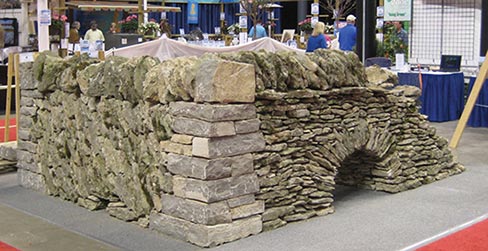 The goal was to establish a new parkway concept that maintained the historic features, farms and natural beauty of the landscape. The historic fences were to be retained as much as possible, either along the original road frontage or in the newly formed median.
The goal was to establish a new parkway concept that maintained the historic features, farms and natural beauty of the landscape. The historic fences were to be retained as much as possible, either along the original road frontage or in the newly formed median.
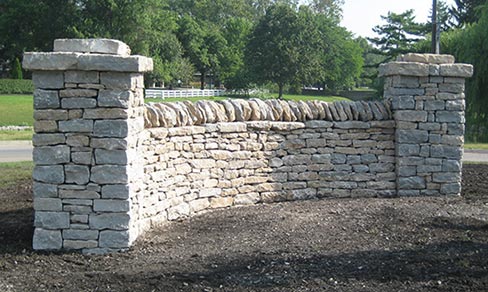 Here we welcome the first key player, Carolyn Murray-Wooley.
Here we welcome the first key player, Carolyn Murray-Wooley.
Carolyn is an architectural historian with a lifelong interest in the stone houses and building traditions of the Scots-Irish who settled the Bluegrass Region.
She has published extensive research on the topic. Carolyn’s daughter, Jane Wooley, remembers stones and historic preservation playing a big role in her childhood.
“As a kid, our outings often included visits to old stone houses,” says Jane Wooley. Coming from a family of builders and historians, it may be no surprise that today Jane has continued in her mother’s footsteps. But we’ll hear more about her later.
In 1995, as construction goals for the Paris Pike project were being set, it became clear that skilled drystone masons would be needed to rebuild over three miles of rock fences that would be impacted within the proposed two-year construction schedule.
“At that time, there just wasn’t anyone that knew how to do it,” said David Kenley, one of the lucky masons who worked with the Conservancy on the Paris Pike restoration.
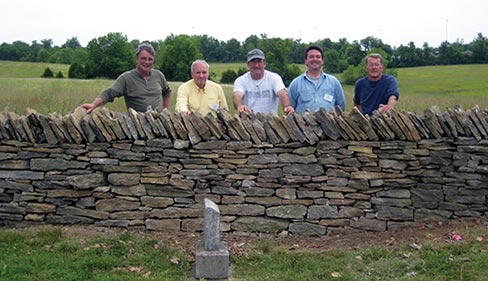 One year later, the Dry Stone Conservancy was born and incorporated as a 501(c)3 organization.
One year later, the Dry Stone Conservancy was born and incorporated as a 501(c)3 organization.
The KHC hired Carolyn to coordinate and conduct a series of training workshops to pre-qualify the drystone masonry subcontractors.
She knew she had to find someone to teach the ancient craft precisely and thoroughly so the fences could be relocated and restored.
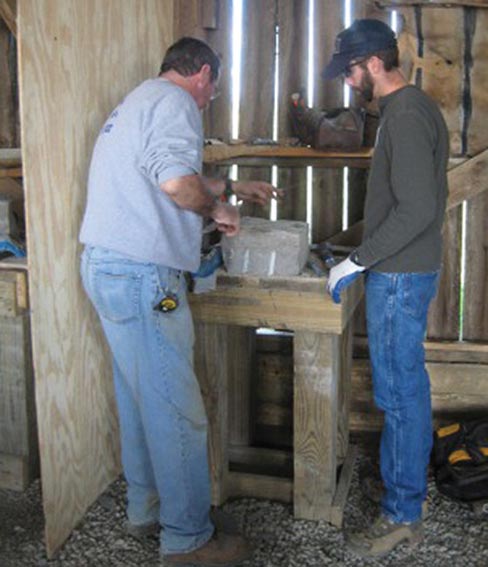 For clarification purposes, Kentucky drystone fences are built from limestone, the local stone of the region, and are constructed according to the ancient technique of laying stones dry, without mortar.
For clarification purposes, Kentucky drystone fences are built from limestone, the local stone of the region, and are constructed according to the ancient technique of laying stones dry, without mortar.
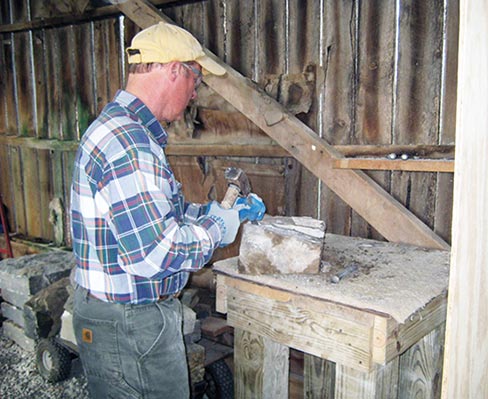 Scots-Irish landowners brought this traditional masonry work with them when they settled in the Bluegrass region.
Scots-Irish landowners brought this traditional masonry work with them when they settled in the Bluegrass region.
By the late 19th century, the masons’ knowledge had also been imparted to the African American slaves, so the trade was preserved well into the early 20th century.
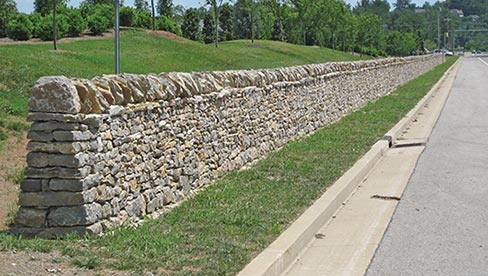 Colloquially called rock fences, not stone walls, they are traditionally-built freestanding walls with a front and back face, packing in the center and a batter on both sides.
Colloquially called rock fences, not stone walls, they are traditionally-built freestanding walls with a front and back face, packing in the center and a batter on both sides.
A top layer of vertically-placed coping stones is also a hallmark of Scottish, Irish and Kentucky drystone fences.
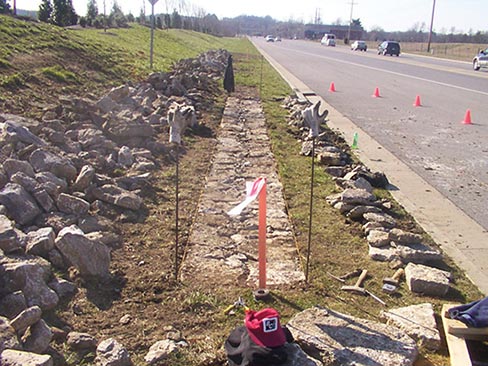 Jane offers three purposes for copings in Kentucky.
Jane offers three purposes for copings in Kentucky.
From an agricultural standpoint, the sharp edges of the rocks used for the coping often dissuade livestock from jumping fences or grazing over them.
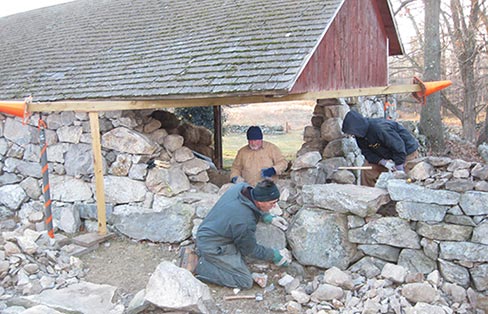 Architecturally, copings are a quick and easy way to add height to a fence.
Architecturally, copings are a quick and easy way to add height to a fence.
Practically, copings make economical use of large thin rocks, which would otherwise have to be broken up and used in the lower parts of the fence.
 Let’s get back to the story. Carolyn went directly to the source of dry stone walling expertise: the Dry Stone Walling Association of Great Britain.
Let’s get back to the story. Carolyn went directly to the source of dry stone walling expertise: the Dry Stone Walling Association of Great Britain.
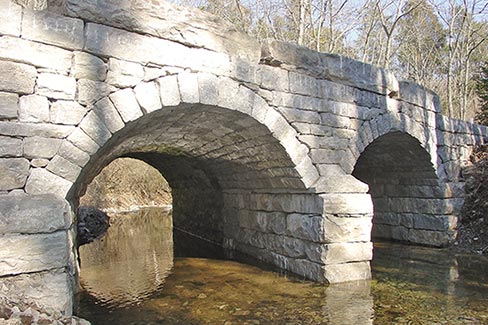 Her search led her to Master Craftsman and walling instructor Richard Tufnell, who was invited to Kentucky to lead the workshops and pre-qualify masons for the project. Richard helped with the Conservancy’s formation and stayed on for five years, leading its other workshops, training and restoration projects.
Her search led her to Master Craftsman and walling instructor Richard Tufnell, who was invited to Kentucky to lead the workshops and pre-qualify masons for the project. Richard helped with the Conservancy’s formation and stayed on for five years, leading its other workshops, training and restoration projects.
Carolyn and Richard did a lot of research together and published several articles and books on the importance of drystone heritage and how the structures were built.
At this point, more and more people began to discover the advantages of drystone construction and its superiority to mortared construction.
Drystone structures have a slight flexibility that allows them to conform to foundation settlement without disruption.
Mortared walls are susceptible to the elements of weather, as frozen rain and snow get trapped in mortared seams and push the joints apart.
However, a correctly-built drystone wall drains naturally without damage.
As awareness of the Conservancy’s mission and work evolved, Jane began helping her mother who could barely keep up with the growing demand for training and restoration. She became a committed staff member in 1997.
By 2000, the Conservancy was in need of additional experienced masons for its continual drystone teaching.
Carolyn and Jane made a trip across the pond to check out the work of other DSWA master craftsmen. This time they found Neil Rippingale.
Enter Neil, a most lively character with a wealth of knowledge. Neil is from Midlothian, Scotland, was owner and managing director of N.R. Stonecraft and worked as an independent construction and walling contractor throughout Scotland and beyond.
Neil was among the first of the master craftsmen who were invited back to Kentucky to continue the Conservancy’s training program. He is now the Conservancy’s Training Program Manager. After the Paris Pike project, Neil had planned to go back to Scotland, but to his surprise, his work visa kept getting extended.
“So I guess they liked me,” he says today.
Neil has been working for the Conservancy since 2000, and like David, the Paris Pike restoration was his first Conservancy project. Many of his responsibilities are tied with the Conservancy but his training and masonry skills are not limited to the Conservancy’s projects in Kentucky.
“Just last year I traveled to 19 different states and trained 300 students,” he says with proud precision. In his 30 years of experience, he has trained 4,650 students in dry stone masonry. Perhaps when working in a trade so tightly woven with history and conservation such impeccable record-keeping skills come naturally.
Today, Jane is the Conservancy’s Executive Director and Restoration Program Manager. She has published numerous articles on the art of drystone masonry and given presentations all over the world about drystone preservation. She has also established multiple partnerships nationally and internationally with drystone associations as well as government agencies like the National Park Services and the National Trust for Historic Preservation.
The alliance with the Kentucky Transportation Cabinet has been particularly advantageous. KyTC consults with the Conservancy to preserve drystone fences and other structures associated with roadways. These interactions often lead to hiring qualified masons or pre-qualifying masons to complete the projects through the state government.
Although the Conservancy is a small organization, its reach is wide; worldwide to be exact. With only two full-time staff members, the Conservancy is able to connect with drystone restoration projects all over the country and with international drystone associations. It is the only nonprofit organization in the United States dedicated to preserving historic drystone structures and to reviving the ancient craft of dry-laid stone masonry.
When the Conservancy is contracted for small projects, such as a fence repair, Neil likes to go out on his own. When the National Park Service or other agency with a large restoration project calls, he and Jane access the Conservancy’s database of trained masons and round up a team for the project.
These masons are assigned and entrusted with restoring heritage works of architecture, not unlike art conservators restoring a famous painting. Through the Conservancy training programs, participants gain a broad understanding of the craft and the restoration projects allow the builder to develop a connection to the material. Many students often express admiration for ancestors when given the opportunity to work on a restoration project.
“It’s really neat to handle the same stone as masons from long ago,” says Jane. This is just one way the Conservancy has fostered widespread appreciation for drystone fences.
Neil always tells his students the stone determines how and what you build. Whether he is building, instructing or supervising Neil is always focused on quality control. Each stone has a role in supporting the overall structure and placement matters. The landscape often dictates the type of structure and style. For example, granite walls are most effective for a wall near a harbor, and limestone works best on Kentucky farmland.
The Conservancy carries out their mission of promoting the ancient craft of dry-laid stone masonry through these instructional training days and volunteer projects. Although now retired, David continues to teach at the Conservancy’s certification workshops each year. Many of the students he has trained are not planning to become professional drystone masons.
“They are mostly homeowners that just want to learn how to enhance their own property,” he says. “They found it cheaper to take the classes and do it themselves rather than hire someone to do it for them.”
With each new drystone fence or bridge built, the Conservancy is instilling an appreciation of the ancient craft, knowledge of proper building techniques and an awareness of architectural and landscape preservation.
For more information about the Dry Stone Conservancy or to learn more about their training programs, visit their website at www.drystone.org.